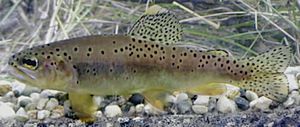Apache trout facts for kids
Quick facts for kids Apache trout |
|
|---|---|
 |
|
| Conservation status | |
| Scientific classification | |
| Genus: |
Oncorhynchus
|
| Species: |
apache
|
The Apache trout, Oncorhynchus apache, is a special type of fish that lives in freshwater. It is part of the salmon family, called Salmonidae. This fish is one of the unique Pacific trouts found in North America.
Contents
What Does the Apache Trout Look Like?
The Apache trout can grow to be about 15 to 60 centimeters (6 to 24 inches) long. It usually weighs between 0.2 to 2.7 kilograms (0.4 to 6 pounds). In its natural home, it rarely gets bigger than 25 cm (10 in), but some can reach up to 40 cm (16 in).
This fish has a beautiful yellowish-gold color with a shiny golden belly. It has dark spots that are spread out evenly. These spots can even go below its side line and onto its back and tail fins. The top of its head and its back are a dark olive green.
The Apache trout looks like it has a black mask or stripe across its eyes. This is because of two small black dots near each pupil. Sometimes, it also has a yellow or gold mark under its lower jaw.
Where Does the Apache Trout Live?
The Apache trout is the official state fish of Arizona. It is one of only two types of trout that are naturally found in Arizona. The other one is the gila trout.
This fish loves clear, cool streams in the White Mountains of Arizona. These streams flow through pine forests and wet, grassy areas. While it naturally lives in these streams, it has also been moved to some lakes in the area.
Apache trout are native to the upper parts of the Salt River watershed, which includes the Black and White rivers. They also live in the upper Little Colorado River watershed. Some Apache trout have been introduced to other streams, like those in the Pinaleño Mountains and the North Rim of the Grand Canyon.
Life Cycle of the Apache Trout
Apache trout lay their eggs, a process called spawning, from March to mid-June. The exact time depends on how high up in the mountains they live. They usually become old enough to reproduce when they are three years old.
The number of eggs a female lays depends on her size. A smaller fish, about 13 to 19 cm (5 to 7.5 in) long, might lay 72 to 240 eggs. A larger fish, about 30 to 35 cm (12 to 14 in) long, can lay 646 to 1,083 eggs. The eggs hatch after about 30 days.
What do Apache trout eat? They enjoy both land and water insects, like caddisflies and flies. If they live in lakes, they also eat small fish and tiny water creatures called zooplankton.
Protecting the Apache Trout
Efforts to help the Apache trout recover and manage its populations have been happening since the 1940s. These fish are raised in special hatcheries run by the government. The fish grown in these hatcheries help increase their numbers and keep populations healthy for sport fishing in certain streams and lakes.
The IUCN says the Apache trout is a critically endangered species. This means it is at a very high risk of disappearing forever. However, under the Endangered Species Act in the United States, it is listed as threatened.
About 100 years ago, Apache trout could be found in about 965 kilometers (600 miles) of streams in the White Mountains. By the late 1960s, their habitat had shrunk to only about 48 km (30 miles) of streams. When the Endangered Species Act was passed in 1969, the Apache trout was one of the first species to be protected. Its population numbers are still growing today.
Today, the biggest dangers to the Apache trout are:
- Mixing with other fish: They can easily cross-breed with rainbow trout. This mixing makes their unique genes less pure. Cutthroat trout are also similar and can cross-breed with Apache trout.
- Forest fires: Large forest fires can harm their habitats.
Even though the Apache trout's natural home is still small, it is now common enough that some limited fishing is allowed. Many of the streams in the Mount Baldy area, which are strongholds for Apache trout, are completely closed to fishing.
However, there are places where you can enjoy catch-and-release fishing for wild Apache trout. There are also many places where you can fish for Apache trout that have been stocked from hatcheries.
Images for kids
See also
 In Spanish: Trucha apache para niños
In Spanish: Trucha apache para niños
- Trinomial from Behnke, 2002.
- Froese, Rainer, and Daniel Pauly, eds. (2012). "Oncorhynchus apache" in FishBase. February 2012 version.



